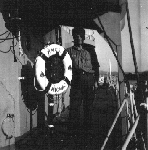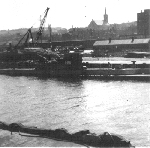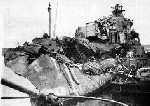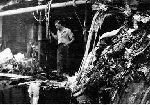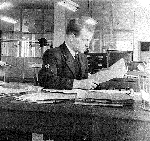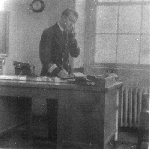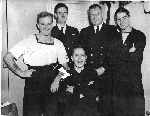Royal
Canadian Navy
On the fifteenth
of April, 1946, I went to Toronto, to the Naval Base HMCS York. At that
time it was located in the Canadian National Exhibition grounds. I was
sworn in with the rank of P/Wtr (Probationary Writer). Writers did not
write, they either worked on the pay records or with the personal records.
HMCS Naden
After a few days I went
with the men who signed on at the same time as myself, by train, to Vancouver.
We took the ferry to Victoria on Vancouver Island. A truck picked us up
and took us to HMCS Naden, the New Entry training base, a few miles from
Victoria. We were then issued our gear, including clothing and hammocks.
We lived in large blocks with rows of tables on each side and rows of lockers
in the middle. In between all of these rows was steel piping on which we
had to sling our hammocks at night. The mick was tied to two of the pipes
with the rope lashing tied alongside of it. To get in you would grab the
lashing, give a push on the floor and pull on the lashing and swing into
the mick. It took me a while the first time. I was afraid of falling out
and lay on my back with my hands crossed on my chest. I didn't expect to
sleep all night but within minutes dozed off. I woke in the morning in
exactly the same position. It didn't take long to be able to grab the lashing,
push and pull swinging the feet into the mick, and then pushing down on
the lashing and plopping into the mick. It was so easy.
Small Group - - - - - - Beard & Buddy - - - - Single
Group
I have few pictures taken at Naden. Men of the Supply Branch (Writers,
Storesmen, Cooks and Stewards) were dressed in the square rig, (peak caps,
shirt and tie, and suit type uniform]. Others were dressed in the round
rig, (round cap with a ship name tally, bell-bottom trousers, etc). When
a group came in each week it was given a name, using ship names. Each group
was a division, ours being the Athabascan. Each division was divided into
classes. The picture on the left is of my class. I am the back, far right,
short person. The one on the right is the Athabascan Division. I am next
to the back, far right man. When on the parade ground and given the order
to fall in, shortest on the left and tallest on the right, I was always
the left most person. I was, and am, 5' 6" tall.
The middle picture is of myself and a friend, who belonged to a different
division. We were dressed in dungs (dungarees) which we wore to most of
our training. I had received permission to grow a beard. Believe it or
not, in this picture I was eighteen years old. In the background of each
picture is a tree called the Monkey Puzzle tree. The reason for the name
is that it is the only tree that monkeys could not climb. It is covered
with the most horrendous thorns that you can imagine.
The RCN had two cruisers, HMCS Ontario and HMCS Uganda. The Uganda
was in the area and tied up at the dockyard. Some of us took the blue boat
(harbour craft) over to visit her. Three of us climbed the mast to the
crowsnest. Boy, when you looked down it was like looking down from the
Empire State Building. To us it was a huge ship and compared to most it
was, unless you are looking at a battleship or one of the big USN aircraft
carriers.
HMCS Givinchy
Our new entry training
lasted three months. After that was completed members of the Supply Branch
moved across the harbour to HMCS Givinchy, a naval base in the dockyard.
Our school and quarters were located there. We spent another three months
taking our Supply courses. One of the best parts of our training was the
nearness of Victoria, a beautiful city with the best looking flower garden
park that I have ever seen.
HMCS Scotian
On finishing both courses we were entitled to two weeks leave. I took the
train back to North Bay for my holiday (in November 1946) and then headed
for HMCS Scotian in the Halifax Dockyard. On my first evening there we
heard a commotion in the hallways. It turned out that the frigate, HMCS
Middlesex, had been at sea when they heard an SOS. They went full speed
ahead and grounded outside of Halifax Harbour. The ship hit a sandbar,
jumped over it and then became fixed. The next day, at low tide, members
of the ship were able to walk to shore with the water coming up to their
knees.
HMCS Micmac
After about three months the base closed
down and was turned into a Reserve Division. In April 1947 I went to the
destroyer, HMCS Micmac. I was there to replace the Leading Writer in the
Pay Office while he was in hospital. The ship was in the dockyard under
refit for the whole period that I was aboard her. After about five weeks
I went to HMCS Stadacona, the main eastern naval station.
Self and Cook - - - - - Eng. Room CPO - - - - - - -U-Boat U190
The first picture is of myself and the ship's cook. The life saver is
the one shown in the second picture of a Chief Petty Officer of the engine
room branch. I wish the left picture was more clear. I would like our faces
to be clearer and I would like the name of the ship to be clear. It came
whitened out. In the background can be seen the shores of Dartmouth. This
was early enough after the war that many ships that had been torpedoed
or fired upon, but made it into Halifax Harbour, are still in the
background. They limped into harbour and either sank, or were scuttled
in a bay on the Dartmouth side. At low tide a good part of the ships could
be seen. I think that one is barely visible to the right of the cook. The
bow is fairly high and the stern under water. I remember one ship that
only showed its funnels at high tide, but at low tide it showed huge amounts
of lumber strapped to the upper deck.
The right hand shot is of the U190, a German U-Boat. It was the second
last one to surrender to the Canadian Navy just outside of Halifax Harbour.
The U899 surrendered the next day. It was turned over to the American Navy
while the U190 was kept by the Canadians for practice and learning. It
was painted yellow. I took this picture from the deck of the Micmac. The
U190 was eventually used for target practice by the Navy and the RCAF.
The Air Force finally sank her.
Shortly after we heard that the Micmac
had completed her refit and had gone to sea for trials. On returning she
entered a fog bank and she and the 10,000 ton freighter Yarmouth County
collided head on. The damage to her port side of the bow was terrible.
Ten men were killed and seventeen badly injured. In one mess there was
only one survivor who had gone to Stadacona to visit the dentist that morning.Working
in the pay office I had made friends with many of these men.
Port Bow- - - - - - Twin Four Inch Guns - - - -Standing in the
Mess
These pictures are of the Micmac after her collision. They were taken just
after she returned to Halifax and tied up. the left shows the bow with
the huge gash that removed the bulkhead completly from the upper two port
messes. A mess is the area where the men live. It contains boot lockers,
eating tables, mick racks and space to sling the micks and lockers. The
central picture shows the forward twin four inch guns, flipped up, back
and over. One open mess is just below it. The third picture shows a man
standing in the mess. He is just below the guns.
The Micmac on trials when she is her real self
The tribal class destroyers were beautiful ships. They could do about 35
knots, almost 40 MPH. As you can see they can turn in a very tight move,
even at high speed. The complement of one of these ships was about 240
officers and men.
HMCS Stadacona
The Stadacona Pay Office was larger than any I had been in before. Pretty
quiet there. A lot of the fellows used to hang out in the Office in the
evenings. One evening I had a couple of pictures taken of me.
At My Desk - - - -Cdr's Jacket
In these early days if you wanted to take a picture at night with office
lights, you had to click the camera and hold it for ten seconds. Very hard
not to move in that long period of time. In the left picture I am pretending
that I am working at my desk. The Supply Officer had left a spare jacket
in his office. The second picture shows me wearing his jacket, holding
a pen and the telephone and trying to look like I am receiving important
information.
Oddly enough a little later I was in the hospital. One of the Admin
Writers met a girl and to try to keep her happy, within a few days, he
went to the Pay Office and stole and forged some pay checks. The RCMP investigated
and one of the officers looked through my friends desk, the man who had
taken the above pictures and was holding the prints. As it turned out the
cheques were typed on my typewriter. The officer did not say anything but
took the pictures in to the Commander to ask who the person in the right
picture was. Nothing was ever said but the Commander never left his jacket
there again.
The forger was caught and held in cells. He went off his rocker that
night, screaming that the devil was under his bunk and trying to get him.
About the same time a Chief Petty Officer was found, in the winter, walking
up Gottingen Street with his briefs and a dressing gown and slippers on,
reading the bible at the top of his voice. He was sent to the hospital
and placed under guard, on the third floor. I was still an up patient at
the time and as a volunteer duty was sitting in the office by the front
door with a window where visitors stopped and asked for room numbers. All
of a sudden the sentry came running around the corner and bounced off of
the opposite wall, then ran for the door and went out. He came right back
and told me that the CPO had jumped out of the window.
We went out and I saw him lying on the steps, face down. They were cement
with nothing but a paper thin bit of ice on them. The guard told me that
the window in his room was open and suddenly the Chief jumped up and went
out of the window head first. The sentry grabbed him by the legs but they
slid through his arms and the Chief went down. I said that we should get
him inside and the sentry picked up his legs and I took him under the chest.
I felt warm liquid and figured that his chest was badly injured. We got
him inside and laid him on the floor and I phoned for help. Then I thought
that I would be in trouble because an accident victim shouldn't be moved
until checked. As it turned out he had a one inch minor cut on his chin
and not another bit of damage. The warm liquid was from his chest melting
the bit of ice and warming it up. I still don't know how he could go from
the third floor to the cement steps with no other injuries. I guess that
his bible reading helped him.
Early in January, 1949, my wife, Marjorie of Yarmouth, NS,
agreed to marry me. I had been in Stad for about two years at that time.
On the 9th of January a friend and I saw something on an officer's desk
that we should not have seen. The next morning at 1100 we went in and told
the officer that the report was in error. At 1330 (1:30 pm) the MAA (Master
At Arms) came in and told the me that I was leaving for the carrier HMCS
Magnificent and my friend was going to the Naval Air Base, which at that
time was way out in the countryside with difficult transportation. That
is HMCS Shearwater.
HMCS Magnificent
I arrived on the Maggie that afternoon and we sailed the next day for England.
During the next three months we were only back in Halifax once, for a few
days, and then we went to areas of the States and the Caribbean.
On my first day out to sea it was rough. I got sea sick as soon as I
got up in the morning. The next morning I was still sick and went to the
canteen and got two chocolate coated ice cream bars. After eating them
my seasickness disappeared. We were heading for Glasgow, Scotland, to pick
up some new Sea Furies. Our fighter planes were Sea Furies and our anti-sub
aircraft were the Avengers. We were also going to pick up three ten ton
destroyer screws. We stopped in Portsmouth, England for a visit. A friend
and I took the train to London for the week end. In 1949 there was still
food rationing in England and, although the debris had been removed, there
were a lot of remains of buildings bombed during the war.
We went to Glasgow and loaded our Furies. We stayed a few days and then
when it was time to leave we had to stay over another night. A storm had
made the waters so rough that we could not leave the harbour. The next
day we did leave and shortly I got sick again. I went up top and stuck
my head into the fresh air. It cleared me up and I was never sea sick again.
About eight of the Furies were tied down on the aft end of the flight
deck. The screws were tied down at the forward end of the deck, in a line
towards the stern. All were forward of the island. At one point the third
screw started to loosen. The fear was that it would break loose as the
bow was rising and sweep aft taking out some of the Sea Furies, like a
bowling alley. Men went out and tried to wire it down but were unsuccessful.
It suddenly broke free just as the ship rolled to starboard and swept across
in front of the island and into the sea.
The next few months were much more pleasant, especially when we went
south. There were five ranks for the men from ordinary seaman to Chief
Petty Officer. That was increased to seven about this time. We now had
two classes of Petty Officer and Chief Petty Officer. Because of good breaks
for the fortunate I was promoted to Petty Officer Second Class, skipping
the Leading Seaman rank. We visited Colon at the east side of the Panama
Canal. Some of us who had been promoted went ashore and wet our hooks.
Hooks is jargon for anchors, two of which a petty officer wore on his left
arm. To wet your hooks means to have a few drinks to celebrate the promotions.
The Magnificent - - - - - - Pay Office Staff
The first picture is the Maggie at anchor. The aircraft seen on the deck
are Seafires. They are basically Spitfires that were altered to allow the
wings to fold back and to be equipped with a tail hook to grab a cable
on landing. The other picture shows the staff of the Maggie. Standing left
to right are myself who maintained the officers pay records, our Commissioned
Officer who was the paymaster, our Petty Officer 1/c who was in charge
of the Pay office, and two writer who handled the remainder of the pay
records. The man on the right switched to Admin later on.
Over the side - - - - - Seafire Landing - - - -Seafire into barrier
The first shot is of a Seafire that caught a cable but swerved over the
side and hung there. The plane was brought back aboard. The middle shot
is a Seafire on the deck and catching a cable to stop him. Failure to get
a cable means going into a steel cable barrier as the third one has done.
The cables usually rip into the engine cowling and near the wing tips to
stop the plane. Without the barrier the plane would continue and pile into
the other aircraft that have landed and moved forward. Most often these
planes would be back in the air by the next day.
We finally got back to Halifax for a short period and then left again for
flying training exercises. We were going to go into Mahone Bay with the
intention of anchoring out for the week-end. It was intended that we would
take boats ashore and have BBQ's on the beach. It was after supper as we
headed in and I was lying on the boot lockers in my mess with my head propped
on my hand, reading a book. Our mess was just aft of the chain locker for
the anchors. All of a sudden I heard a big noise and said to myself, "There
go the hooks". Then I started to bounce about six inches off of the lockers.
I looked up and out the door to the weatherdeck and saw one of the two
destroyers that had been following us in line astern. It went up the port
side about 30 or 40 feet out. I ran to the weatherdeck and looked forward.
The destroyer was just ahead of us and facing to our stern. She had done
a 180 degree turn, as did the other one on the starboard side.
We had run 200 feet up on a rock. Standing on the deck I could feel
a strong vibration and hear quite a noise. It was the water pouring into
the ship. I went to the flight deck and we figured that we could hit the
shore with a stone. All the aircraft were moved to the stern and the order
was given for all personnel to go to the stern. The two destroyers went
aft up us and tied to our stern. The went full ahead as we went full aft.
We didn't move a bit. Luckily we had hit at low tide. Finally at midnight,
just as we were hitting high tide a grinding noise started and we slid
back into the water. We went at about 10 knots back to Halifax, arriving
in the early morning.
I called Marge about 0800. She told me that she had been reading in
bed around midnight and decided to go to sleep. She wanted to hear the
news and turned on her radio in the midst of a report on the Maggie. She
told me that they ended with the words, "It is not known if anyone was
killed or injured, yet." No one was hurt.
HMCS Iroquois
We had 100 UNTD (University Naval Training Division) Cadets on board, officers
of the future. The Maggie had to go into a long refit so the destroyer
HMCS Iroquois was brought out of moth balls to continue their training.
A skeleton crew of 140 officers and men were selected to man her for the
training period remaining, about three months. Luckily I was one of those
selected, otherwise I would have had to go to St. John, NB for the refit
period.
The Wartime Iroquois - - - - - - And in Peace
The time spent on the Iroquois was only three months. One evening, on return
from a cruise, we arrived in Halifax Harbour but could not tie alongside
because of a very strong storm. We dropped anchor in the harbour. A little
later we received an SOS from a Russian ship at sea east of Cape Breton.
They had lost their steering. We left immediately and headed out into the
bad weather to assist. By daylight we had located the Russian. They had
attached cables to the rudder and to two winches and were using this setup
up to steer for harbour. The ship would swerve from port to starboard and
back continually. We accompanied them for some time but they refused to
take a tow from us and we eventually headed back for Halifax.
We made our final return to Halifax in September, 1949. The Iroquois'
sailing days were over again and she would soon be paid off again. Marge
and I were married on 9th September. We went on a two week honeymoon on
a lake across the highway from St. Margaret's Bay. We took a taxi to get
there. The driver was very hard of hearing and at one point we heard a
train whistle. The tracks crossed the road ahead of us at a sharp angle.
The driver looked back and then forward and continued on his way. The train
was coming from the other side and missed us with a roar behind the car,
missing us by what appeared to be inches. Marge just about passed out and
neither of us could speak for a bit. the driver never knew what happened.
HMCS La Hulloise
The Frigate La Hulloise in an English harbour during the war
From the Iroquois I went to HMCS La Hulloise. It was a temporary move prior
to my reporting to HMCS Shearwater, the Naval Air Base. There was a weird
setup there. She was tied alongside in the dockyard. I ate and slept on
board but our offices were on the shore. Never got sea sick once.
HMCS Shearwater
From the La Hulloise I went to HMCS Shearwater, the Royal Canadian Naval
Air Station. I was there for less than a year. The Supply Officer told
me different times that I was very good at my job. Then I learned to drive
in his Navy jeep. Soon after I had a near accident with it and was charged
with reckless driving and speeding. I was found 'not guilty' but did not
have an MT6, the Naval driver's licence. From that time on the Supply Officer
did and said anything that he could to hurt me. One day the Chief Writer
asked me if I wanted to make the Navy my career. I said I did and he replied
that he was sorry.
The Supply Officer of the Micmac had told me when I left the ship, that
he was going as Officer-In-Charge of the Drafting Depot, where all moves
were handled. He said that if he could ever help me to let him know. After
the Chief's message I called the Depot and spoke to the Lieutenant now
in charge. I told him that I had a problem and would like to get moved
to HMCS York in Toronto, Ontario. It is a Naval base used for Reserves
with a small staff of RCN. The Lieutenant asked me when I would like to
go. I said, "Today". He laughed but I was on my way in two or three days.
HMCS York
During my period in York I was promoted to Petty Officer 1/c. I was able
to get back into the square rig. After two years at York I returned to
Shearwater. All new staff by this time, of course. After a couple of years
I missed the sea. A new Aircraft Carrier, HMCS Bonaventure, was supposed
to be about ready to take the place of the Magnificent. I requested the
Captain for a move to the Bonnie. He told me that it would not be ready
for a couple more years, but that I could go to the Maggie. I agreed.
HMCS Magnificent
Instead of the Maggie my move was to the cruiser HMCS Uganda, which had
now been renamed to HMCS Quebec. It was currently in refit in a drydock
at the Halifax Shipyards. I was only there for about seven weeks when I
was informed that the PO on the Maggie was being sent ashore because of
compassionate reasons, sickness of his wife. By this time PO 1/c's could
be the Pay Bob which previously had to be an officer. That was my job on
the Maggie. I was in charge of the Pay Office and handled the cash. On
paydays a number of officers assisted with the general payment. We had
a crew of about 1,200, with the air crew aboard, and we each paid about
200. On my first payday I was really worried about mistakes. I would have
to pay for anything short. When I finished the payment I rushed back to
the Pay Office and balanced the cash. Right on. We were on the way to England
at the time for a three month refit in Portsmouth. Because of that, after
the payment was made we had to go back to our pay stations and exchange
money for English pounds. While doing it someone noticed that I had given
him 100 pounds too much and handed it back to me. When finished I was really
scared and got back to the office for another balance. It was right on
again, thanks to that man.
I enjoyed the aircraft carrier because we were able to watch during
take offs and landings. That was very exciting. Nobody ever wanted to see
anyone hurt but all those watching during flying exercises loved to see
a plane make a poor landing or even a crash. I didn't have a regular camera
with me but I did have my movie camera. I was able to recently get pictures
made from these, even though the films were now over 40 years old and transferred
to tape, unprofessionally. I lost the .JPG files but had printed them in
a Wordperfect file and then I scanned those copies. Each step deteriorated
the shots, but better than nothing.
Among some of the crashes that I witnessed was a Sea Fury that hit
the round down (an area at the stern end of the flight deck that rounded
down so that a plane that hit too low could bounce up instead of smashing
into it). This one then rose and cleared the second barrier and went under
the third one. The first one is always down. One of the cables on the barrier
hit the canopy and sliced through it, hitting the pilot's helmet and denting
it. The plane then caught fire, but strictly gas. There was no smoke but
the gas went over the side and down into a weather deck below. Rescue crew
ran to the plane in their fire proof outfits and got the pilot out. Then
they covered it with foam. The pilot ended up with a headache.
Another Fury hit the round down and then bounced up but picked up No.
1 cable. It lost one wheel on the first impact and then when the cable
ran out it slammed down onto the deck ramming the second wheel through
the wing. The pilot was not hurt.
An Avenger was landing one day while I was at my goofing station on
the aft end of the smoke stack. Talking at the time and when I realized
he was not going to pick up a cable I grabbed my camera and got a shot
just as he went into No. 2 barrier and the right wing tip hit the island.
No injuries.
A Sikorsky chopper lifted off the deck one day and at about 20 feet
the rotors locked. It slammed down onto the deck and the pieces flew all
about. No injuries.
There were quite a few more but I know of no other injuries in any of
those accidents.
| SeaFury Crash |
Chopper Crash |
Guppy Near Miss |
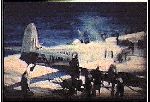
|
 |
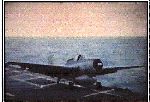 |
SeaFury Crash This
is the Fury that caught fire. The firemen with their fire proof outfits
are covering the plane with foam that smothers the flames. When they were
finished the entire plane was covered.
Chopper Crash This
is the Sikorsky that crashed. The pieces were spread for quite a distance
and it ended up on it's side. Some time earlier I had a ride as passenger
in the aft section of a Sikorsky. We were off the west coast of Mexico.
I had a belt around my waist with an extension going to a lock on the other
side of the chopper. I could stand on the edge of the doorway and lean
out to take movie shots. We passed over a large school of porpoises and
I took a picture. The pilot said he would come lower so I could get a better
shot. He did a 360 turn and descended so that we were very close, but I
had run out of film. We then saw two huge sting rays flying in formation
just under the surface of the water.
Guppy Near Miss A
Guppy is an Avenger with a large bowl on the underside of the engine cowling.
The plane would drop sonar equipment into the water and the plane equipment
would then pick up any signals from submarines. The plane carried depth
charges which it could then drop. This one caught a cable but veered to
the side and came within a few inches of going over.
One day a Fury took up a drogue, a long sleeve
at the end of a line, for firing practice. On completion of the excercise
it would fly across the ship and drop the line so that it crossed the deck.
On this day the line went aft and wound up in the screws. The Maggie had
to stop so that the line could be removed. It took quite a while and the
Furies and Avengers flew around the area waiting. To make proper landings
they need to fly at a slow speed, with the Maggie going at full speed into
the wind, and with a fair wind. By the time they got things cleaned up
it was getting towards evening and the aircraft were getting low on fuel.
The Furies came in first because they had the
higher stall speed. The wind had dropped but they all managed to make it,
although a couple came within inches of the No. 2 barrier. Then the Avengers
started. One picked up a cable but did like the one in the picture above,
only he went over the side into a gun sponson. The deck crew started working
on getting it aboard but were having trouble. I guess that the metals of
the plane were tangled with the metal of the gun and equipment in the sponson.
Finally the order came down from the island to the deck chief that he had
five minutes to get it aboard or it was to be pushed overboard. The planes
were really getting low on fuel by this time. In about three minutes they
managed to get it aboard and the remainder of the planes came in.
Someone in the deck crew reported that he had
seen a man sunbathing in the sponson before the accident. They looked for
him but he was not found. The order was given for all personnel to report
to their messes and the mess leaders were to take a roll call. One man
was reported missing, a cook. It was believed that the plane had thrown
him overboard. Shortly after one of the deck crew found him. He was in
the gun sponson one aft of the crash site. He had fallen asleep and slept
through the crash and all of the work recovering the plane.
One day we were off of the English coast when
an exercise was planned. All of the aircraft were going to take off, form
into squadrons, fly two hours to England and then do a mock bombing attack
on an RAF base. I was lucky enought to get a seat in the Navigator's chair.
It is behind the pilot and can be swivelled 100 degrees by a hand crank.
This flight was the day after the fury crashed in the picture above. Some
of my mess mates suggested that I would refuse to go. Ha. I was told that
on takeoff I was to face forward and on landing to face aft. I wanted to
get a shot of the ship dropping away behind so on take off I turned the
seat to face aft. After we got into the air the planes formed up. We then
headed for the coast and the Sea Furies flew ahead of us crossing back
and forth from left to right in 'S' turns.
We flew over land for awhile and then the three
or four planes to our left started to peel off, one after the other,
and dive away towards the ground. Then it was our turn. Shortly we came
in very low and did a pass over the base. I felt that we were down to about
fifty feet. We started to climb and passed some hangars. When we got back
up we peeled off again and did another pass from the opposite direction.
After that we had another two hour flight back to the ship.
We passed up the starboard side of the ship and
did a left turn for the cross leg. Left turn for the downwind. I had set
my seat to face forward so that I could get good shots as we came in. We
turned left again for the base leg and then left for the final approach.
At this point I had to stop the camera because the ship could not be seen
from my seat. I had been told that it was quite a jolting thing when a
cable was picked up. We touched down and I felt a bounce and thought that
this was not bad. Then we got the cable and what a feeling. My head felt
like a balloon expanding and made me quite dizzy. It lasted for seconds
only.
We went forward and parked. When I got out of
the plane I looked back and saw that the barrier was up and the next plane
was on final. I got a shot of it, the only time I had seen a landing from
the forward side of the barrier.
| Avenger Forming Up |
RAF Base |
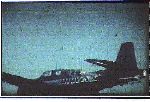
|
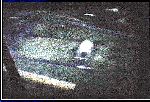 |
| Landing Circuit |
Next Landing |
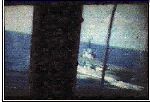
|
 |
Avenger Forming Up After
the take off, when we got into position, the next Avenger came up on our
starboard side and got into formation with us. It almost looked like he
was on an elevator, rising straight up in level flight.
RAF Base On
our first pass I got a shot of one of the hangars as we started to climb.
It was easy to see men on the ground watching us as we went over.
Landing Pattern When
this shot was taken we were just turning to the left to line up aft of
the Maggie for the final approach.
Next Landing This
shot was taken just as the Avenger came to a halt at the end of the cable.
Just as I finished taking it someone yelled down to me from the island
to get away from there.
One time we did a cruise that took us through the Panama Canal and
up to Victoria, B.C. and return. We stopped at Los Angeles on the way up
and then Vancouver and San Diego on the way back. While in Vancouver we
received a message that there had been a cave in of a large bank of the
canal. Because of that we would have to go around South America to get
home. It was early December and everyone wanted to be home for Christmas,
although the South American cruise would have been nice.
When we got to San Diego we received another message that stated enough
repairs had been made that would allow us to go back by the canal. As we
approached the area it was obvious where the problem was. A huge area of
the bank showed a gouge and earth could be seen sticking out of the water.
We had to go to the extreme right side of the area and from the flight
deck you could just about reach out and touch the leaves on the trees.
While in San Diego some of us visited the PX and I bought my first movie
camera there. I have pictures of the passage by the cave in.
One day while we were at sea there was a pipe made that a leak had
occurred in the aviation fuel tank. This was next to the ammunition supplies.
All personnel were ordered to go as far foreward or aft as possible. This
was in case of an explosion. I doubt if it would have helped much but it
would give some people a chance I guess. The leak had gone into a space
that had over a foot of av gas build up. The leak was stopped and the fuel
cleaned up. I'd rather go up on a rock any day.
On another day in the Caribbean we could see a huge tornado in the distance.
We changed direction to steer clear of it, but it was an interesting sight
to see. No real danger because we were quite a distance away.
HMCS Shearwater
In July 1955 I returned to Shearwater and stayed there until July 1958.
That made three times in Shearwater and twice in Magnificent. This time
I ran the monkey cage (cash cage).
One evening when Marge and I were having supper we heard a news report
that there had just been a crash at Shearwater. We were living in a Temporary
Married Quarters house in Clarence Park. The houses were all of the wartime
housing type. There were four streets, each two blocks long. Clarence Park
was about half a mile past Shearwater. When I heard the report I went outside
and I could see volumes of black smoke rising into the sky.
A Canadian Naval pilot was taking off in an Avenger while an American
pilot was doing touch and goes with a Banshee jet. The Americans radio
had gone on the blink and he was doing a landing. The Canadian was taking
off on a different runway that crossed the one the American was landing
on. The tower called to the Banshee to warn him of the Avenger, trying
a few times and getting no answer. They switched to the Avenger but it
was too late. They met at the intersection and both planes went up in a
mass of flames and smoke. Both were killed instantly.
Across the street from Clarence Park was the Fairey Aviation building.
They had test pilots who check flew Shearwater planes that had major overhauls
at Fairey's. One had gone through a test at Shearwater where pilots sat
in a made up cockpit and on a signal they would get the canapy open, get
out of their belts and jump over the side into a net. They were required
to do it in a certain number of seconds. The test pilot could never make
it. One day he was checking out an Avenger and doing touch and goes. After
one touch down he accelerated and took off again. The engine burst into
flames within seconds. For a parachute to open you had to have 500 feet
below you. The plane was not at that height but the pilot got out very
quickly and jumped just as it passed a steep hill that gave him the extra
height that he needed. He landed with no injuries. The plane continued
and flew over the Naval Air Maintenance School (NAMS) and cleared the back
section by a few feet. It then went over a jetty and building while spewing
out flaming gas, and crashed into the water between the shore and McNab's
Island. The jetty was set on fire and had a fair amount of damage.
One day Marge and I and our son, Wayne, were driving to the Shearwater
post office for the mail. I saw a Fury flying east over McNab's Island
and said to Marge that I thought the pilot was in trouble. We got our mail
and as we started for home heard a fire engine. I said that it must have
been the Fury. We saw some smoke in the distance and I headed for it. I
parked the car at the side of the road and trekked through the bush and
found the plane. There was a Lieutenant and a number of other people there,
some Naval. The Fury was broken in two with the rear half upright and the
front half upside down. It was completely engulfed. We thought that the
pilot was burned to ashes, but a work crew arrived and the P.O. told me
that he was in the hospital. He had minor injuries.
It happened that as he crashed a Sikorksy chopper with two pilots was
passing on its way to Shearwater. They saw the crash and flew over to it.
There was no movement and no place close by to land. It hovered at tree
top level and the second pilot jumped to the ground. He got to the Fury
and found that the cockpit was jammed. He got a rock and smashed it and
got the pilot out. He then helped him to a clearing where the chopper had
come down and they headed for the hospital at Shearwater.
I was introduced to curling at Shearwater. While forming a group of
interested parties we had a meeting in a building that is now the Shearwater
Museum. We heard a loud noise as we were finishing up and looked out the
window to see two Banshees diving nearby. They pulled up and a wing tank
of one came off. The plane rolled over and the pilot ejected the other
tank and his canopy but crashed into McNabb's Island and was killed instantly.
HMCS Algonquin
In July of 1958 I went aboard the destroyer, HMCS Algonquin. She was in
Summerside, Prince Edward Island and I had to take a Naval bus to meet
her. While in Shearwater the last time I had gone for my trade group four
course in the Supply School at Lasall, Quebec, just a few miles from Montreal.
The course qualified me for Ship's Writer, a combination of pay and administration.
I was now in and admin position, the Captain's Secretary. Our Captain wore
two hats. He was Squadron Commander of four destroyers and Captain of the
Algonquin. He had a Sub Lieutenant as squadron secretary.
On 15th September 1958 I was promoted to Chief Petty Officer 2/c. We
were at sea at the time and when we got home Marge met me in the dockyard
with the car. I drove us out and saw one of our seamen walking and offered
him a lift. He got in that back and said, "Thanks, Chief". Marge turned
to me and said, "That's the first time I heard anyone call you Chief.".
The Berlin crisis was on while I was in Algonquin. We had to send destroyers
to work out of St. Johns, Newfoundland. We patrolled the waters where the
Russian ships were. Most of them were fishing vessels, including cannery
ships. Some were disguised tankers.
We did gunnery practice using icebergs as targets. I remember the first
time I watched. I was waiting to see the four inch shells hit it and blow
it into pieces. When the shells hit they left black marks but no visible
damage at all. We did seven patrol sessions during that year. That did
not give us much time at home. Finally it was all over.
Next we went to Bermuda and operated from the dockyard there for three
months. We would go out Mondays and come back Fridays. After the three
months we went to the Virgin Islands, St. Thomas island to be exact. We
were tied alongside a jetty with a huge American supply ship on the other
side. Some of us went to a beach one day. It was very nice and one of our
PO Cooks used a spear gun to go out and shoot a fish.
After a couple of days a group of stokers went to the beach for party
time. I was duty Chief of the Day that day. This was the duty that second
class CPO's did, letting the Officers of the Day relax in the wardroom.One
of their men did not return by 2300 when all leave was up. I checked with
his mess and the fellows there told me about the party. The last time he
had been seen he was feeling sick and went into the jungle. Nobody thought
of him after that. I went across to the Supply Ship and asked if we could
have the jeep driver take me to the beach to look for him. We got there
and parked on the little roadway that parralled the beach. I suggested
the driver walk up the road and I'd go up the beach. We didn't go far before
I heard someone call out. I called back and it was our missing man. He
had got lost in the jungle and panicked. He ran through brambles and was
scratched from head to toe. We got him back to the ship.
Finally, near the end of 1959, we went of to the NATO exercises off
of Europe. We had a few incidents on the way but finally made it across
the ocean. After the exercise was over we went to Antwerp, Belgium for
a short stay. Because we were into December and ready to go home our Captain
decided that since the North Atlantic was very rough in December, we would
take the southern route via the Azores. We were only out about two days
when we were hit by a 140 mile an hour hurricane that lasted three days.
The Bonaventure, aircraft carrier, was with us but because they had a very
sick man on board they went into the Bay of Biscay to fly him ashore. That
made them a day behind us.
All of the ships were badly damaged. We had two compartments that were
flooded, lost the radar set off of the foreward guns and the breakwater
was ripped out of the deck on the starboard side leaving a gash about three
feet wide in the middle and fifteen feet long. The Algonquin had been altered
including an addidtion of a deck. This helped us with our life rafts. We
lost one but the other three destroyers lost just about all of theirs.
The daily lists of damage that we received from the other destroyers and
the complete one that we sent to Headquarters was getting extremely long.
At one point while we were in the mess at stand easy, we lot all power.
We started to broach in 85 foot waves. A 90 degree turn would have rolled
us right over. The emergency power came on and we turned back into the
wind. It failed as well and the second emergency power came on (the last
one). We held our breaths for quite a while but it held until the primary
power was repaired. We finally got out of it and arrived in the Azores.
When I got home Marge told me that the news came on every half hour
and they described what was going on with the ships. They always ended
with the message that "None of the ships have sunk -- yet!"
HMCS D'Iberville
From there I went to HMCS D'Iverville in Quebec City. It was a base where
new recruits from Quebec who did not speak English went before New Entry
Training at Cornwallis. They learned enough English to get them through
the NE training.
After a year and a half they closed the base and moved the English classes
to HMCS Hochelaga in Lasalle. I went to Hochelaga as Paymaster and in charge
of the Pay Office.
HMCS Hochelaga
After two years I was drafted to the Bonaventure. Our Suppy Officer left
and his replacement called me in and asked me if I would be willing to
stay for another year because he didn't like to take over with a new Chief.
I agreed. Our mess issued an engraved mug to each member when he left,
with the from and to dates engraved on it. Mine had been made ready but
was held since I was staying. The next year I was again drafted to the
Bonnie and my replacement was a man who had never done pay office work.
I was asked if I would be willing to stay another year and be an instructor.
I agreed again. The mug had already been engraved again with the new year
on it.
I really enjoyed the instucting. I had four classes during the year.
I took one class to DNPA (Director of Naval Pay Accounting) in Ottawa for
a look around. They were the trade group four class. While there we were
asked to take an apptidute test for programmers. Sometime in the near future
the pay end would be going to computers and programmers would be needed.
We took the test and I qualified. We were told that this would not get
us the jobs but would give them a list that they could call on if and when
things went the right way.
Our Lieutenant Commander who was the head of the instructors was pleased
with my results and he asked me if I would stay on for another year. I
told him that there was no way that he would get approval. He said that
he was sure he would and I agreed again. After a few days he came to me
and said that he couldn't work it. This time I was issued my mug with yet
another date on it.
HMCS Stadacona
I was to report to Stadacona and then to the Bonnie. But when I got to
Stad I was told that the Chief that was on the Bonnie had stayed on each
time I was cancelled and that now she was going to make a trip around South
America and that it was only fair that he stay on. So I was going to stay
in Stadacona.
The year was 1965 and I had been inland for five and a half years.
So I was back in the office that I had left in January 1949, only in charge
this time. After a few months a message came that said they were looking
for Writers to take the apptidude test for programmers. Any message received
in Headquarters would result in a test being mailed. It stated that it
was for Petty Officers only. Our Supply Officer had just recently come
from DNPA and he said that he thought I should have a chance. He sent a
message and a test came for me. Every one else had already done theirs,
197 across the country.
It turned out that six of us qualified with the test. Two were not available
and the four remaining went to Headquarters for a six week course to see
if we really had the aptitude. There were only three positions and when
we finished we had all done equally well. The army gave up one of their
positions so that we could all go back.
CFHQ
In January 1965 we moved back inland, to Ottawa. I was now stationed at
Canadian Forces Headquarters. There were seventeen of us in our group.
Our purpose was to write programs to put the pay system on computers for
the three combined forces. First we had to learn to write in COBOL. We
were given three books that had questions and answers. We spent each morning
for three weeks going through the books and learning the language. In the
afternoons we worked in the offices, writing program portions before we
even finished the book course. That was our total learning spree, the rest
was from experience.
On 1st March 1967 I was promoted to CPO 1/c. There was only one C1 allowed
for each coast for the pay and one for administration. That was the total
for the whole Navy. It was very meaningful to receive it, even though I
retired a year and a half later.
We worked on a number of different computers and then purchased our
own. That cost a fortune. It was set up in a building across the river
in Hull. There were a total of 17 of us in four offices, from a Major down
to P2's and army and airforce sargeants. I was with a Flight Lieutenant
and an Air Force Sargeant. After two years the pay system was ready, a
huge amount of programming. Most of it was in one large program that was
too large for the computer and had to be divided into the main system and
a slave system. It took four hours to compile each part of the program
from COBOL to machine language. With a home computer now a fairly large
program can be compiled in the blink of an eye.
I retired in April of 1968, although my time extended to October because
of rehabilitation leave. I then joined the Food and Drug Directorate and
stayed with them for the next sixteen years.
Return
To Personal Page







